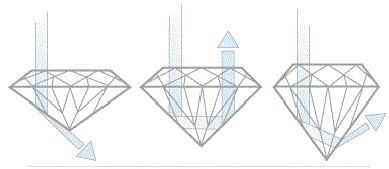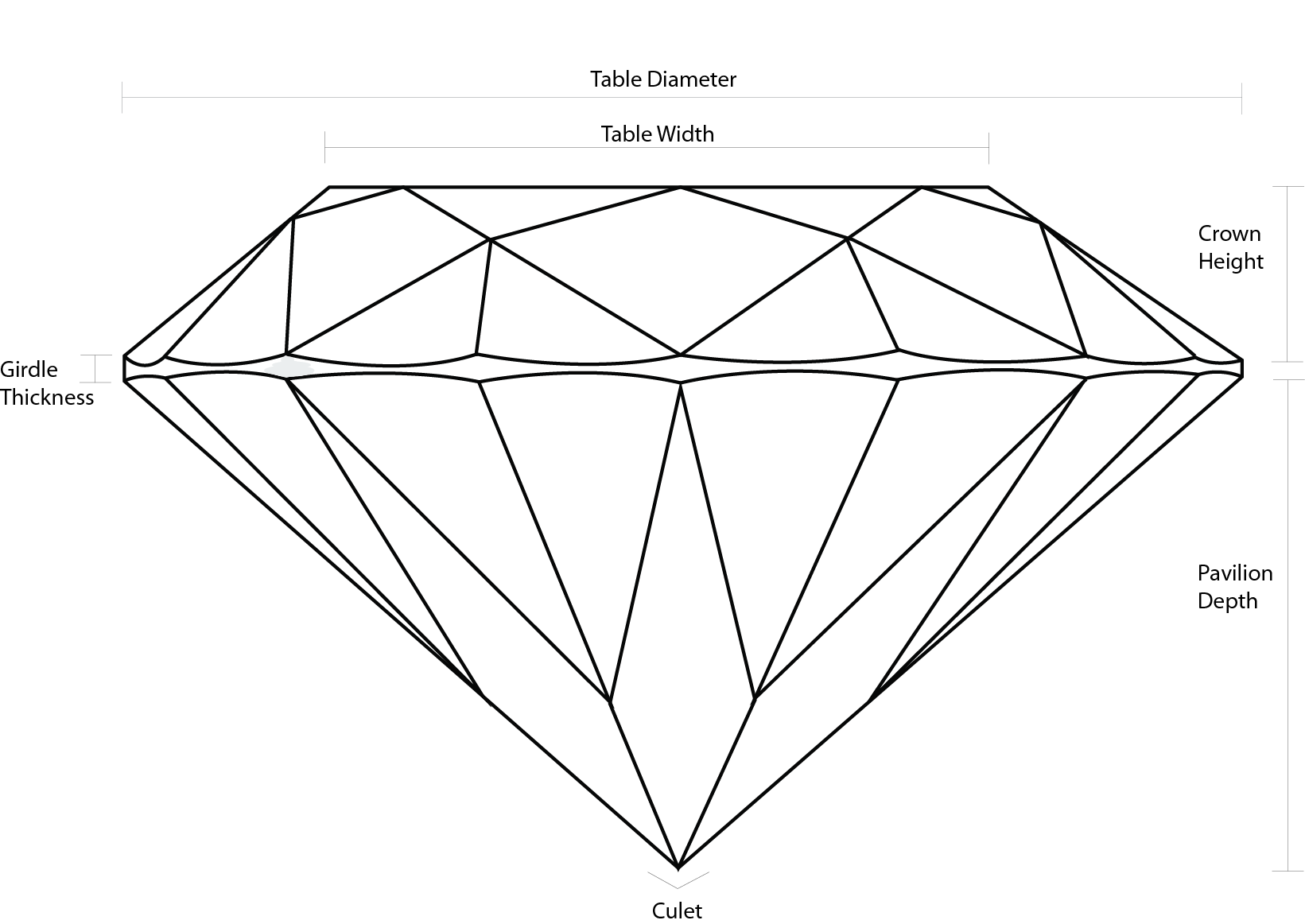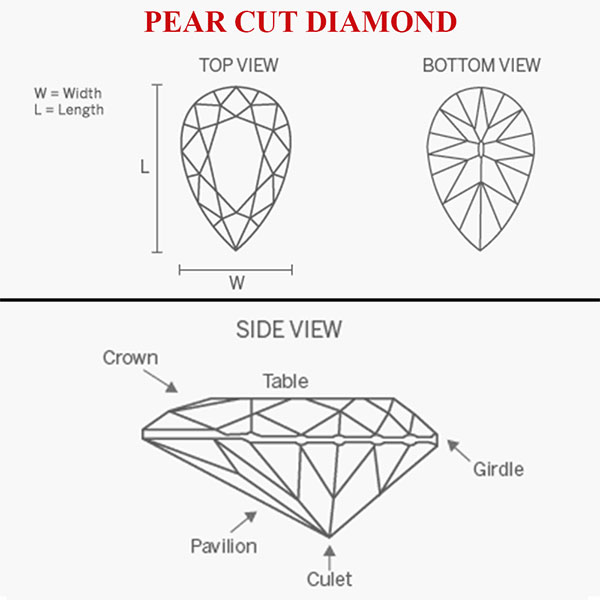Until the middle of the twentieth century, there was no agreed-upon standard by which diamonds could be judged. GIA created the first, and now globally accepted standard for describing diamonds: Color, Clarity, Cut and Carat Weight. Today, the 4Cs of Diamond Quality is the universal method for assessing the quality of any diamond, anywhere in the world. The creation of the Diamond 4Cs meant two very important things: diamond quality could be communicated in a universal language, and diamond customers could now know exactly what they were about to purchase.
Clarity refers to the inclusion and blemishes of a diamond; the level of clarity is determined by the number, size, place, whether it is obvious and the general effect of those inclusions and blemishes to the appearance of a diamond. Since diamonds are formed naturally, the formation process would usually include some other substances which lead to so called crystals, feathers inside a diamond. Better clarity gives a higher value of a diamond.
Flawless (FL) - No inclusions or blemishes are visible to a skilled grader using 10× magnification
Internally Flawless (IF) - No inclusions and only blemishes are visible to a skilled grader using 10× magnification
Very, Very Slightly Included (VVS1 and VVS2) -Inclusions are difficult for a skilled grader to see under 10× magnification
Very Slightly Included (VS1 and VS2) - Inclusions are minor and range from difficult to somewhat easy for a skilled grader to see under 10x magnification
Slightly Included (SI1 and SI2) - Inclusions are noticeable to a skilled grader under 10x magnification
Included (I1, I2, and I3) - Inclusions are obvious under 10× magnification and may affect transparency and brilliance
Since the diamond with “Included” grading includes quite obvious inclusion, we do not recommend and also do not offer diamonds with Grade I1 , I2 & I3 , except customers request us to provide.

The carat is the diamond’s physical weight measured in metric carats. One carat equals 1/5 gram and is subdivided into 100 points. Carat weight is the most objective grade of the 4Cs.
Carat weight is the most objective of the diamond’s 4Cs. All that is required is a precisely balanced scale capable of measuring extremely small weights.
Carat weight started with the carob seed, when early gem traders used the small, uniform seeds as counterweights in their balance scales. Today, the carat is the same milligram weight in every corner of the world.
Color and clarity are born naturally with a diamond; however, on the other hand, Cutting is determined by the craftsmanship the diamond receives, which is an important factor to lead the diamond to sparkling perfection. The cutting factor involves complex determination, as a value factor, though, it refers to a diamond’s proportions, symmetry and polish.

Too Shallow Ideal Cut Too Deep
Understanding what diamond color means helps in choosing the right diamond. Interestingly, the diamond color evaluation of most gem-quality diamonds is based on the absence of color. A chemically pure and structurally perfect diamond has no hue, like a drop of pure water, and consequently, a higher value. GIA’s D-to-Z diamond color-grading system measures the degree of colorlessness by comparing a stone under controlled lighting and precise viewing conditions to masterstones of established color value.
While every diamond is unique, all diamonds share certain structural features. A diamond’s anatomy, or its basic structure, determines its proportions, brilliance, dispersion and scintillation. Each part of the diamond has a specific name, and having a basic understanding of how each part contributes to the diamond as a whole will help you find your perfect diamond.
A diamond is comprised of the eight main components. They are Diameter, Table, Crown, Table Spread, Girdle, Pavilion, Depth, and Culet. Below is a brief description of each part of a diamond and its location.
• Diameter: The width of a polished stone, measured from edge to edge.
• Table: The largest polished facet located on the top of the diamond.
• Crown: The top part of a diamond extending from the table to the girdle. The crown is made up of bezel facets (crown mains), star facets, upper girdle facets (upper halves), and a table facet.
• Girdle: The very edge (widest edge) of the diamond where the crown and pavilion meet.
• Pavilion: The bottom part of a diamond extending from the girdle down to the culet.
• Depth: The total height of a diamond measured from the table to the culet.
• Culet: The small or pointed facet at the very bottom of the diamond.

Before purchasing a diamond, make sure that you have a basic understanding of a diamond’s anatomy. This will allow you to truly appreciate diamonds and all their intricacies, communicate with experts about a particular diamond, and, most importantly, it will assist you in making a well-thought out decision about which diamond is best for you.
Pointers and dimensions of the diamond is one of the important factors in valuation of fancy shapes diamonds. It is considered as a factor for deciding price of diamonds.
The weight of per piece diamonds is measured in carats. The number of piece in 1 carats goods is known as the average pointers of the parcel. For loose diamonds, the price of the parcel is decided based on the average pointers size of the parcel.
For example:- 1/10 pointers size means 10 pieces in one carats. The diamonds in the parcel ranges from 0.08 cts to 0.125 cts which makes average size of the parcel as 0.09 to 0.10 cts size. Similarly the pointers ranges as 1/6, 1/5, 1/4, 1/3, 1/2, 5/8, 3/4, 4/4.
| Pointers | Weight range/piece | Average size of parcel |
|---|---|---|
| 1/10 | 0.08 to 0.124 | 0.09 |
| 1/6 | 0.125 to 0.174 | 0.14 to 0.15 |
| 1/5 | 0.175 to 0.219 | 0.19 to 0.20 |
| 1/4 | 0.220 to 0.289 | 0.24 to 0.25 |
| 1/3 | 0.290 to 0.369 | 0.30 to 0.31 |
| 3/8 | 0.370 to 0.449 | 0.39 to 0.40 |
| 1/2 | 0.450 to 0.590 | 0.49 to 0.50 |
The fancy shape diamonds has main two dimensions as length and width of the diamond. The length and width are two important factors for price calculation of the parcels.

Diamond Length-Width (L/W) Ratio
The length and width ratio of the diamond indicates its proportionate length and width. The length and width ratio signify how the diamond would look from the face i.e. top view. The L/W ratio gives an idea how big or small the stone will appear, also defining its shape. Diamonds with different ratios shape-up different; this ratio can make a princess cut diamond look rectangular, a heart skinny or bloated. It is important to evaluate all the shapes except round since it measures the same through out. Fancy shape diamonds like Princess, Asscher, Marquise, Emerald, Radiant, Cushion, Oval, Pear, Heart etc., all have a certain basic length-to-width ratio that is considered to make the diamonds look more brilliant.
How to Calculate L/W Ratio?
A simple formula can help get the L/W ratio of the diamond. To calculate the L/W ratio just divide the length of the diamond by its width. For e.g. a pear shaped diamond with a length of 7.5 mm and a width of 5.0 mm will have 1.50: 1 length-to-width ratio.
Length of the DiamondWidth of the Diamond
The diamond shape is though a matter of personal taste, but there are certain set standards to describe the best L/W ratio.
Copyright © 2021 Yug Global Pvt. Ltd. All Right Reserved.